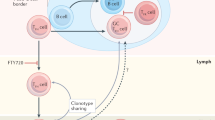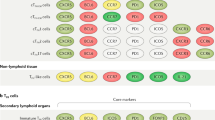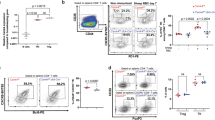Abstract
Increased numbers of T follicular helper (Tfh) cells have been implicated in the development of autoimmune diseases including primary Sjögren’s syndrome (pSS), but how the Tfh cell response is regulated during autoimmune pathogenesis remains largely unclear. Here, we first found negative correlations between IL-10+ regulatory B (Breg) cell numbers and Tfh cell responses and disease activity in patients with pSS and mice with experimental Sjögren’s syndrome (ESS). Moreover, we detected high expression of IL-10 receptor on Tfh cells and their precursors in both humans and mice. In culture, IL-10 suppressed human and murine Tfh cell differentiation by promoting STAT5 phosphorylation. By using an adoptive transfer approach and two-photon live imaging, we found significantly increased numbers of Tfh cells with enhanced T cell homing into B cell follicles in the draining cervical lymph nodes of RAG-2−/− mice transferred with IL-10-deficient B cells during ESS development compared with those of RAG-2−/− mice transferred with wild-type B cells. In ESS mice, CD19+CD1dhiCD5+ Breg cells with decreased IL-10 production exhibited severely impaired suppressive effects on T cell proliferation. Consistently, CD19+CD24+CD38hi Breg cells from pSS patients showed significantly reduced IL-10 production with defective inhibitory function in the suppression of autologous Tfh cell expansion. Furthermore, the adoptive transfer of IL-10-producing Breg cells markedly suppressed the Tfh cell response and ameliorated ESS progression in ESS mice. Together, these findings demonstrate a critical role for IL-10-producing Breg cells in restraining the effector Tfh cell response during pSS development.
This is a preview of subscription content, access via your institution
Access options
Subscribe to this journal
Receive 12 digital issues and online access to articles
$119.00 per year
only $9.92 per issue
Buy this article
- Purchase on Springer Link
- Instant access to full article PDF
Prices may be subject to local taxes which are calculated during checkout






Similar content being viewed by others
References
Fox, R. I. Sjogren’s syndrome. Lancet 366, 321–331 (2005).
Nocturne, G. & Mariette, X. Advances in understanding the pathogenesis of primary Sjogren’s syndrome. Nat. Rev. Rheumatol. 9, 544–556 (2013).
Pflugfelder, S. C. & de Paiva, C. S. The pathophysiology of dry eye disease: what we know and future directions for research. Ophthalmology 124, S4–S13 (2017).
Mingueneau, M. et al. Cytometry by time-of-flight immunophenotyping identifies a blood Sjogren’s signature correlating with disease activity and glandular inflammation. J Allergy Clin. Immunol. 137, 1809–1821 e1812 (2016).
Szabo, K. et al. Follicular helper T cells may play an important role in the severity of primary Sjogren’s syndrome. Clin. Immunol. 147, 95–104 (2013).
Brokstad, K. A., et al. T follicular-like helper cells in the peripheral blood of patients with primary Sjogren’s syndrome. Scand. J. Immunol. 88, e12679 (2018).
Alunno, A. et al. CD4(-)CD8(-) T-cells in primary Sjogren’s syndrome: association with the extent of glandular involvement. J. Autoimmun. 51, 38–43 (2014).
Lin, X. et al. Th17 cells play a critical role in the development of experimental Sjogren’s syndrome. Ann. Rheum. Dis. 74, 1302–1310 (2015).
Lin, X. et al. The role of T helper 17 cell subsets in Sjogren’s syndrome: similarities and differences between mouse model and humans. Ann. Rheum. Dis. 73, e43 (2014).
Fu, W. et al. Deficiency in T follicular regulatory cells promotes autoimmunity. J. Exp. Med. 215, 815–825 (2018).
Nurieva, R. I. et al. Bcl6 mediates the development of T follicular helper cells. Science 325, 1001–1005 (2009).
Ueno, H., Banchereau, J. & Vinuesa, C. G. Pathophysiology of T follicular helper cells in humans and mice. Nat. Immunol. 16, 142–152 (2015).
He, J. et al. Circulating precursor CCR7(lo)PD-1(hi) CXCR5(+) CD4(+) T cells indicate Tfh cell activity and promote antibody responses upon antigen reexposure. Immunity 39, 770–781 (2013).
Simpson, N. et al. Expansion of circulating T cells resembling follicular helper T cells is a fixed phenotype that identifies a subset of severe systemic lupus erythematosus. Arthritis Rheum. 62, 234–244 (2010).
Liu, D. et al. T-B-cell entanglement and ICOSL-driven feed-forward regulation of germinal centre reaction. Nature 517, 214–218 (2015).
Ou, X., Xu, S. & Lam, K. P. Deficiency in TNFRSF13B (TACI) expands T-follicular helper and germinal center B cells via increased ICOS-ligand expression but impairs plasma cell survival. Proc. Natl Acad. Sci. USA 109, 15401–15406 (2012).
Maynard, C. L. & Weaver, C. T. Diversity in the contribution of interleukin-10 to T-cell-mediated immune regulation. Immunol. Rev. 226, 219–233 (2008).
Candando, K. M., Lykken, J. M. & Tedder, T. F. B10 cell regulation of health and disease. Immunol. Rev. 259, 259–272 (2014).
Katz, S. I., Parker, D. & Turk, J. L. B-cell suppression of delayed hypersensitivity reactions. Nature 251, 550–551 (1974).
Flores-Borja, F. et al. CD19+CD24hiCD38hi B cells maintain regulatory T cells while limiting TH1 and TH17 differentiation. Sci. Transl. Med. 5, 173ra123 (2013).
Daien, C. I. et al. Regulatory B10 cells are decreased in patients with rheumatoid arthritis and are inversely correlated with disease activity. Arthritis Rheumatol. 66, 2037–2046 (2014).
Wu, H. et al. Epigenetic regulation in B-cell maturation and its dysregulation in autoimmunity. Cell Mol. Immunol. 15, 676–684 (2018).
Blair, P. A. et al. CD19(+)CD24(hi)CD38(hi) B cells exhibit regulatory capacity in healthy individuals but are functionally impaired in systemic lupus erythematosus patients. Immunity 32, 129–140 (2010).
Yanaba, K. et al. A regulatory B cell subset with a unique CD1dhiCD5+ phenotype controls T cell-dependent inflammatory responses. Immunity 28, 639–650 (2008).
Yang, M. et al. IL-10-producing regulatory B10 cells ameliorate collagen-induced arthritis via suppressing Th17 cell generation. Am. J. Pathol. 180, 2375–2385 (2012).
Achour, A. et al. Human regulatory B cells control the TFH cell response. J. Allergy Clin. Immunol. 140, 215–222 (2017).
Tian, Y., Mollo, S. B., Harrington, L. E. & Zajac, A. J. IL-10 regulates memory T cell development and the balance between Th1 and follicular Th cell responses during an acute viral infection. J. Immunol. 197, 1308–1321 (2016).
Xiao, F. et al. Proteasome inhibition suppresses Th17 cell generation and ameliorates autoimmune development in experimental Sjogren’s syndrome. Cell Mol. Immunol. 14, 924–934 (2017).
Fisher, B. A. et al. Standardisation of labial salivary gland histopathology in clinical trials in primary Sjogren’s syndrome. Ann. Rheum. Dis. 76, 1161–1168 (2017).
Xu, H. et al. Follicular T-helper cell recruitment governed by bystander B cells and ICOS-driven motility. Nature 496, 523–527 (2013).
Vitali, C. et al. Classification criteria for Sjogren’s syndrome: a revised version of the European criteria proposed by the American-European Consensus Group. Ann. Rheum. Dis. 61, 554–558 (2002).
Kamanaka, M. et al. Memory/effector (CD45RB(lo)) CD4 T cells are controlled directly by IL-10 and cause IL-22-dependent intestinal pathology. J. Exp. Med. 208, 1027–1040 (2011).
Choi, Y. S. et al. LEF-1 and TCF-1 orchestrate T(FH) differentiation by regulating differentiation circuits upstream of the transcriptional repressor Bcl6. Nat. Immunol. 16, 980–990 (2015).
Liu, X. et al. Transcription factor achaete-scute homologue 2 initiates follicular T-helper-cell development. Nature 507, 513–518 (2014).
Singer-Lahat, D., Liu, J., Wess, J. & Felder, C. C. The third intracellular domain of the m3 muscarinic receptor determines coupling to calcium influx in transfected Chinese hamster ovary cells. FEBS Lett. 386, 51–54 (1996).
Ishikawa, Y. et al. Identification of AQP5 in lipid rafts and its translocation to apical membranes by activation of M3 mAChRs in interlobular ducts of rat parotid gland. Am. J. Physiol. Cell Physiol. 289, C1303–C1311 (2005).
Kruse, A. C. et al. Structure and dynamics of the M3 muscarinic acetylcholine receptor. Nature 482, 552–556 (2012).
Nguyen, K. H. et al. Evidence for antimuscarinic acetylcholine receptor antibody-mediated secretory dysfunction in nod mice. Arthritis Rheum. 43, 2297–2306 (2000).
Robinson, C. P. et al. Transfer of human serum IgG to nonobese diabetic Igmu null mice reveals a role for autoantibodies in the loss of secretory function of exocrine tissues in Sjogren’s syndrome. Proc. Natl Acad. Sci. USA 95, 7538–7543 (1998).
Yang, M. et al. Novel function of B cell-activating factor in the induction of IL-10-producing regulatory B cells. J. Immunol. 184, 3321–3325 (2010).
Linterman, M. A. et al. Foxp3+ follicular regulatory T cells control the germinal center response. Nat. Med. 17, 975–982 (2011).
Nus, M. et al. Marginal zone B cells control the response of follicular helper T cells to a high-cholesterol diet. Nat. Med. 23, 601–610 (2017).
Sage, P. T., Francisco, L. M., Carman, C. V. & Sharpe, A. H. The receptor PD-1 controls follicular regulatory T cells in the lymph nodes and blood. Nat. Immunol. 14, 152–161 (2013).
Yang, M., Rui, K., Wang, S. & Lu, L. Regulatory B cells in autoimmune diseases. Cell Mol. Immunol. 10, 122–132 (2013).
Arnold, C. N., Campbell, D. J., Lipp, M. & Butcher, E. C. The germinal center response is impaired in the absence of T cell-expressed CXCR5. Eur. J. Immunol. 37, 100–109 (2007).
He, J. et al. Low-dose interleukin-2 treatment selectively modulates CD4(+) T cell subsets in patients with systemic lupus erythematosus. Nat. Med. 22, 991–993 (2016).
Galeazzi, M. et al. OP0099 Safety, tolerability and initial signs of efficacy of the fully human immunocytokine DEKAVIL (F8IL10): a novel therapeutic approach for rheumatoid arthritis. Ann. Rheumat. Dis. 76, 92–93 (2017).
Marlow, G. J., van Gent, D. & Ferguson, L. R. Why interleukin-10 supplementation does not work in Crohn’s disease patients. World J. Gastroenterol. 19, 3931–3941 (2013).
Mosanya, C. H. & Isaacs, J. D. Tolerising cellular therapies: what is their promise for autoimmune disease? Ann. Rheumat. Dis. 78, 297–310 (2018).
Psianou, K. et al. Clinical and immunological parameters of Sjogren’s syndrome. Autoimmun. Rev. 17, 1053–1064 (2018).
Kwun, J. et al. Successful desensitization with proteasome inhibition and costimulation blockade in sensitized nonhuman primates. Blood Adv. 1, 2115–2119 (2017).
Acknowledgements
We thank Dr. Helen Zhi from the Biostatistics and Clinical Research Methodology Unit, The University of Hong Kong, who provided valuable suggestions for the statistical analysis. We thank the professional service provided by the Faculty Core facility, The University of Hong Kong. This work was supported by grants from the National Natural Science Foundation of China (81771761 and 91842304); Chinese National Key Technology R&D Program, Ministry of Science and Technology (2017YFC0907601 and 2017YFC0907605); General Research Fund, Hong Kong Research Grants Council (17114515 and 17149716); Hong Kong Croucher Foundation (260960116); and Sanming Project of Medicine in Shenzhen (SZSM201512019).
Author information
Authors and Affiliations
Contributions
L.L. and X.L. designed and conceived the experiments. X.L. performed the experiments. X.W., F.X., K.M., X.W., L.L., D.X., F.W., X.S., Y.Z. and D.L. provided patient samples and analyzed data. All of the authors interpreted the data and discussed the results. L.L. and X.L. prepared the manuscript.
Corresponding authors
Ethics declarations
Competing interests
The authors declare no competing interests.
Rights and permissions
About this article
Cite this article
Lin, X., Wang, X., Xiao, F. et al. IL-10-producing regulatory B cells restrain the T follicular helper cell response in primary Sjögren’s syndrome. Cell Mol Immunol 16, 921–931 (2019). https://doi.org/10.1038/s41423-019-0227-z
Received:
Accepted:
Published:
Issue Date:
DOI: https://doi.org/10.1038/s41423-019-0227-z
Keywords
This article is cited by
-
Inflammatory cytokines and their potential role in Sjogren’s syndrome risk: insights from a mendelian randomization study
Advances in Rheumatology (2024)
-
Epigenetic regulation of B cells and its role in autoimmune pathogenesis
Cellular & Molecular Immunology (2022)
-
c-Myc-driven glycolysis polarizes functional regulatory B cells that trigger pathogenic inflammatory responses
Signal Transduction and Targeted Therapy (2022)
-
Regulatory B cell repertoire defects predispose lung cancer patients to immune-related toxicity following checkpoint blockade
Nature Communications (2022)
-
Aryl hydrocarbon receptor activation drives polymorphonuclear myeloid-derived suppressor cell response and efficiently attenuates experimental Sjögren’s syndrome
Cellular & Molecular Immunology (2022)



